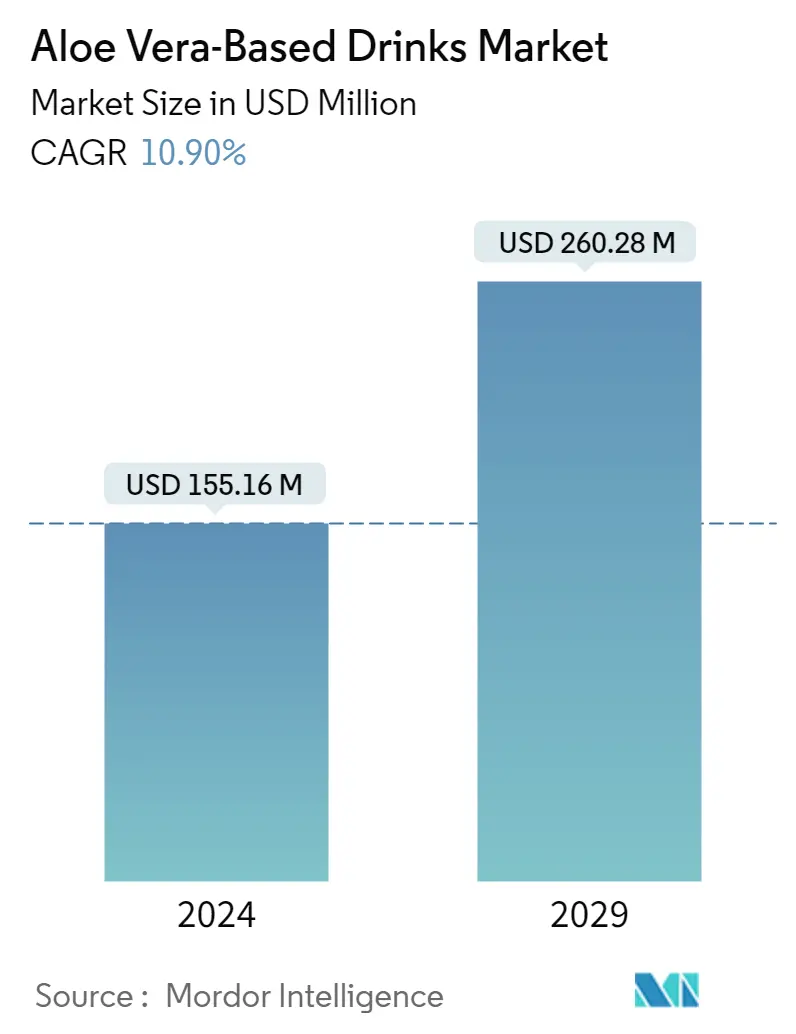Market Size of Aloe Vera-Based Drinks Industry

| Study Period | 2019 - 2029 |
| Base Year For Estimation | 2023 |
| Market Size (2024) | USD 155.16 Million |
| Market Size (2029) | USD 260.28 Million |
| CAGR (2024 - 2029) | 10.90 % |
| Market Concentration | Low |
Major Players
*Disclaimer: Major Players sorted in no particular order |
Aloe Vera-Based Drinks Market Analysis
The Aloe Vera-Based Drinks Market size is estimated at USD 155.16 million in 2024, and is expected to reach USD 260.28 million by 2029, growing at a CAGR of 10.90% during the forecast period (2024-2029).
- The demand for aloe vera-based drinks is rising among consumers due to rising consciousness towards vitamin-deficiency conditions promoting the growth of such drinks. The plant extracts contain over 200 biologically-active components, including essential vitamins and minerals, natural sugars and agents, amino acids, and enzymes that stimulate the immune system and promote healing. Aloe Vera-based drinks are recommended for diabetics, heart patients, and allergies as well, which is further supplementing the market growth at the global level.
- Also, the rising application of aloe vera for multiple purposes such as health care, cosmetics, food, and other applications supports these markets, further complementing the growth of aloe vera-based drinks in forecast years. However, bloating and digestive issues caused by such drinks are expected to act as market restraining factors.
Aloe Vera-Based Drinks Industry Segmentation
Aloe vera-based drinks are made of aloe vera plant leaf flesh and are marketed as healthy for health and skin.
The global aloe vera-based drinks market is segmented by product type into hot drinks, bottled drinks, juice concentrates, and aloe vera water. By distribution channel, the categories are supermarkets/hypermarkets, convenience/grocery stores, specialty stores, and other distribution channels. By geography, the market is segmented into North America, Europe, Asia-Pacific, South America, and the Middle East and Africa.
The market sizing and forecasts have been done based on USD million value for each segment.
| By Product Type | |
| Hot drinks | |
| Bottled drinks | |
| Juice Concentrates | |
| Aloe Vera water |
| By Distribution Channel | |
| Supermarkets/Hypermarkets | |
| Convenience/Grocery Stores | |
| Specialty Stores | |
| Online Retail Stores | |
| Other Distribution Channels |
| Geography | |||||||||
| |||||||||
| |||||||||
| |||||||||
| |||||||||
|
Aloe Vera-Based Drinks Market Size Summary
The aloe vera-based drinks market is experiencing significant growth, driven by increasing consumer awareness of health benefits associated with vitamin-rich beverages. These drinks are gaining popularity due to their content of over 200 biologically-active components, including essential vitamins, minerals, and enzymes that support immune function and healing. The market is further bolstered by the versatility of aloe vera in various sectors such as healthcare, cosmetics, and food, which enhances its appeal as a natural and organic product. Despite some concerns regarding digestive issues, the demand for aloe vera-based drinks continues to rise, particularly among consumers seeking natural alternatives to artificial beverages.
In the Asia-Pacific region, the shift towards healthier lifestyle choices and the preference for organic products are driving the demand for aloe vera-based drinks. The increasing presence of market players offering innovative and natural products in countries like India and China is expected to further boost market growth. The competitive landscape is marked by product innovations, such as the introduction of drinks with fresh aloe vera pulp and organic ingredients, which cater to the growing consumer preference for non-GMO and vegan options. Major players in the market are focusing on enhancing the nutritional benefits of their products to capture a larger market share, contributing to the dynamic nature of the global aloe vera-based drinks market.
Aloe Vera-Based Drinks Market Size - Table of Contents
-
1. MARKET DYNAMICS
-
1.1 Market Drivers
-
1.2 Market Restraints
-
1.3 Porter's Five Forces Analysis
-
1.3.1 Threat of New Entrants
-
1.3.2 Bargaining Power of Buyers/Consumers
-
1.3.3 Bargaining Power of Suppliers
-
1.3.4 Threat of Substitute Products
-
1.3.5 Intensity of Competitive Rivalry
-
-
-
2. MARKET SEGMENTATION
-
2.1 By Product Type
-
2.1.1 Hot drinks
-
2.1.2 Bottled drinks
-
2.1.3 Juice Concentrates
-
2.1.4 Aloe Vera water
-
-
2.2 By Distribution Channel
-
2.2.1 Supermarkets/Hypermarkets
-
2.2.2 Convenience/Grocery Stores
-
2.2.3 Specialty Stores
-
2.2.4 Online Retail Stores
-
2.2.5 Other Distribution Channels
-
-
2.3 Geography
-
2.3.1 North America
-
2.3.1.1 United States
-
2.3.1.2 Canada
-
2.3.1.3 Mexico
-
2.3.1.4 Rest of North America
-
-
2.3.2 Europe
-
2.3.2.1 Spain
-
2.3.2.2 United Kingdom
-
2.3.2.3 Germany
-
2.3.2.4 France
-
2.3.2.5 Italy
-
2.3.2.6 Russia
-
2.3.2.7 Rest of Europe
-
-
2.3.3 Asia-Pacific
-
2.3.3.1 China
-
2.3.3.2 Japan
-
2.3.3.3 India
-
2.3.3.4 Australia
-
2.3.3.5 Rest of Asia-Pacific
-
-
2.3.4 South America
-
2.3.4.1 Brazil
-
2.3.4.2 Argentina
-
2.3.4.3 Rest of South America
-
-
2.3.5 Middle-East and Africa
-
2.3.5.1 South Africa
-
2.3.5.2 Saudi Arabia
-
2.3.5.3 Rest of Middle East and Africa
-
-
-
Aloe Vera-Based Drinks Market Size FAQs
How big is the Aloe Vera-Based Drinks Market?
The Aloe Vera-Based Drinks Market size is expected to reach USD 155.16 million in 2024 and grow at a CAGR of 10.90% to reach USD 260.28 million by 2029.
What is the current Aloe Vera-Based Drinks Market size?
In 2024, the Aloe Vera-Based Drinks Market size is expected to reach USD 155.16 million.

